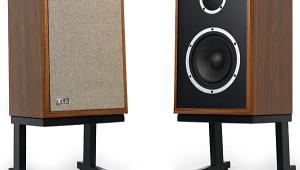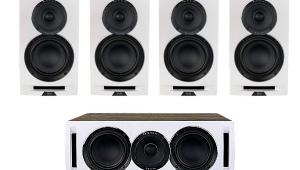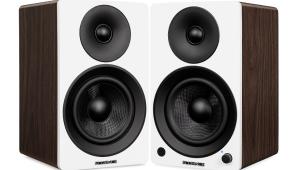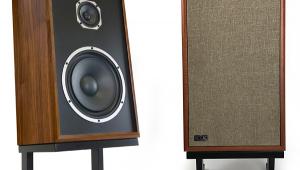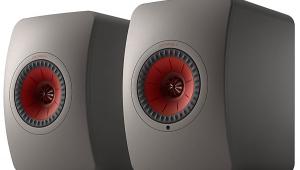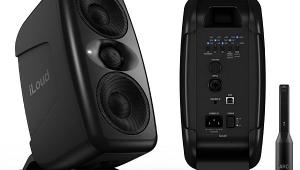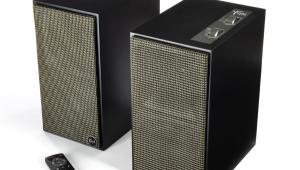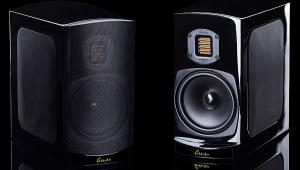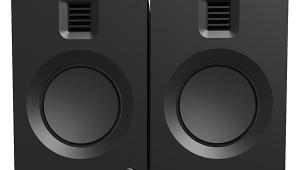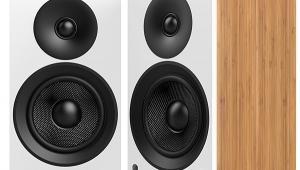Klipsch Reference Premiere RP-140SA Atmos Elevation Module Review Page 2
I Like My Height Bright
Unlike ceiling-mounted height speakers, which beam sound directly toward the listening position, Atmos-enabled speakers and elevation modules bounce sound off the ceiling. This indirect means of reaching the listener requires directivity control over as wide a bandwidth as possible to convincingly enable the ceiling bounce effect. Not all frequencies are going to remain intact on the round trip to the ceiling and back; that’s why I’m not as concerned about conventional timbre matching between the height section of Atmos-enabled speakers and other speakers in the system. I’m not saying it doesn’t matter, just that so far it doesn’t seem to be as critical. Most likely it’s what I’d call the net timbre (the timbre after taking the ceiling’s modification of the speaker’s response into account) that we perceive and should be matched. In fact, at least in my high-ceilinged room, I prefer a brighter sound in the height channels to help bring the effects into greater relief. The RP-140SA fit my needs perfectly. I didn’t have to put an ear to each one to make sure it was operating; even low-level height effects were fairly discernible. Because the height channels have a 180-hertz lowfrequency cutoff when Atmos-enabled speakers or modules are selected during setup, limited bass from the 4-inch woofers wasn’t an issue.

The Age of Adaline isn’t an action-packed thriller with ballistics and car demolitions. Instead, this low-key drama tells the story of a woman who unwittingly acquires immortality and then has to live with it. However, the movie’s insistent use of height effects made it a good, if subtle, demo for the Klipsches. From the opening notes of the orchestral score—a drawn-out drone that sets the mood—the add-ons palpably filled the top part of the 360-degree surround bubble. The car crash (not really a spoiler; it occurs early) was accompanied by height effects, though they were secondary to activity in the surrounds and sub. Surround 5.1.4 is, after all, a team effort among all the channels. Incidental background music also got height enrichment, including a tinkling piano in a party scene and music accompanying an intimate dinner at home. What was interesting about these two snatches of background music was that they were present only in the rear height channels. I wondered if the mixer had been trying to avoid creating distractions in the front. I was glad that the Klipsches made me aware of those two music effects; I was also glad they didn’t overdo it.
In the Heart of the Sea stars Chris Hemsworth as the first mate of a whaling ship in 1820; the epic disasters that he endures would eventually inspire Herman Melville’s Moby-Dick. Compared with The Age of Adaline, this movie has a soundtrack with more dramatic highdecibel moments, but its use of Atmos is more sparing. The mixer saved it for moments when the protagonist is literally immersed, either in a squall or underwater. I appreciated the Klipsches’ explicit voicing—otherwise, I might have missed these effects. The most poignant use of height was for the aquatic moans of the whale.
The Dolby Atmos Blu-ray Demo Disc of 2015 gave the Klipsches many chances to shine, especially in the audio-only clips. The add-ons combined with the floor speakers and sub to convey the enormity of a 747 passing overhead and the mechanical titillation of a helicopter circling around the upper soundfield. But the intricacies of a Santeria ceremony hinted at a more fulfilling use of the medium, with the Klipsches complementing the musical adeptness of the Paradigms and the Denon to conjure hoots, calls, shaker, bongo, and chimes. It was spooky to be surrounded by all that, especially with some of it overhead. Movie clips could be as gentle as the rain that accompanies the fighting in John Wick or as forceful as the electromagnetic levitating-car scene in Transformers: Age of Extinction, a whiz-bang effects-laden sequence that remains one of the most amusing early moments of the Age of Atmos.
Setting the Expansion Modes to Music
The Dolby Atmos package includes Dolby Surround, a listening mode that converts stereo, 5.1, and 7.1 content to 5.1.4 and other height-enhanced configurations. The DTS equivalent is DTS Neural:X. Although I didn’t use DTS:X in the movie demos, I did compare Neural:X with Dolby Surround in the music demos.
The Venetian Concertos, by David Chesky, was recorded by the Orchestra of the 21st Century. The FLAC 48/24 files came courtesy of HDtracks. The music playfully combines the arpeggiated energy of the Italian Baroque with contemporary urban and Latin styles. Chesky (the label) embeds rich lodes of ambience into their recordings, and this one was never less than fulfilling in its original two channels; I was reluctant to tamper with it. But the derived-height-enhanced modes did help fill the full height, width, and depth of the room with the string-dominated score, converting the existing reverb into something approaching a wraparound concert-hall feel. (A live orchestra always sounds more like surround than stereo.) I’m referring not just to height channels, but to the whole soundfield, since the derived-height modes also extend a two-channel signal to the surround and center channels. What broke the spell was the solo flute that floats above the strings. Dolby Surround dispersed it to every channel, sounding obviously artificial. But DTS Neural:X kept it front and center, where it belonged—slightly diffused, but not fatally.

For Pink Floyd’s The Endless River, I played the Blu-ray Disc’s uncompressed PCM 96/24 soundtrack in 5.1. The mostly instrumental album uses keyboard parts recorded by the late Richard Wright during sessions for The Division Bell, with later guitar and drum overdubs by David Gilmour and Nick Mason. Gilmour’s guitar solos, like splashes of trebly color on a canvas of amorphous keyboard texture, got a little extra air and space in the two height-enhanced listening modes. I preferred the overall texture of DTS Neural:X, as it was a little less bright than Dolby Surround (and parts of the album tend toward brightness already). But I wasn’t entirely comfortable with either listening mode, especially on the album’s final cut, “Louder Than Words,” the only track with lyrics. The unadorned 5.1 soundtrack was cleaner, more coherent, and more appropriate for the song than either of the enhanced presentations.
Nick Drake’s Pink Moon (LP) is starkly recorded voice and acoustic guitar, with a rudimentary piano solo on the title track. I wondered whether the Klipsch’s bright voicing would mar the familiar timbres of this well-loved album. It didn’t: Dolby Surround and DTS Neural:X didn’t send enough information to the height channels to interfere. But they did push the voice into the center speaker. The guitar, recorded with a wider stereo spread, appeared in all three front channels. None of this revisionism interfered with my enjoyment of the album, as heard through my system of five identical floor speakers.
When I moved on to the fuller arrangements of Drake’s Five Leaves Left, instruments mixed to hard left or hard right—like Richard Thompson’s electric guitar in “Time Has Told Me”—took up their usual positions, with Drake’s vocal and acoustic guitar still sticking to the middle. The height modes picked up certain treble-rich elements, such as Harry Robinson’s string arrangement for “River Man”; the modes lofted the serpentine orchestral lines up into the Klipsches, which offered a little more air. Overall, the modes were aesthetically neutral on this album: They didn’t make it better or worse, just different.
The Klipsch Reference Premiere RP-140SA is an elevation module that served the height-channel effects in my system quite well. Their horn-loaded tweeters provide both power efficiency and controlled directivity, which may help the perception of high-frequency sound coming from above. I can’t say with certainty how they’ll mate up with other speakers of a different sonic signature than my Paradigms, but if you love your existing speakers and want your height effects to be as explicit and discernible as possible, these Klipsches may be the ticket. For me, they’re just what the doctor ordered.


